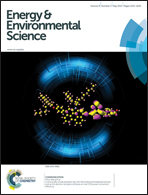Toward the rational design of non-precious transition metal oxides for oxygen electrocatalysis
Abstract
In this Review, we discuss the state-of-the-art understanding of non-precious transition metal oxides that catalyze the oxygen reduction and evolution reactions. Understanding and mastering the kinetics of oxygen electrocatalysis is instrumental to making use of photosynthesis, advancing solar fuels, fuel cells, electrolyzers, and metal–air batteries. We first present key insights, assumptions and limitations of well-known activity descriptors and reaction mechanisms in the past four decades. The turnover frequency of crystalline oxides as promising catalysts is also put into perspective with amorphous oxides and photosystem II. Particular attention is paid to electronic structure parameters that can potentially govern the adsorbate binding strength and thus provide simple rationales and design principles to predict new catalyst chemistries with enhanced activity. We share new perspective synthesizing mechanism and electronic descriptors developed from both molecular orbital and solid state band structure principles. We conclude with an outlook on the opportunities in future research within this rapidly developing field.

- This article is part of the themed collection: 2015 most accessed Energy & Environmental Science articles


 Please wait while we load your content...
Please wait while we load your content...